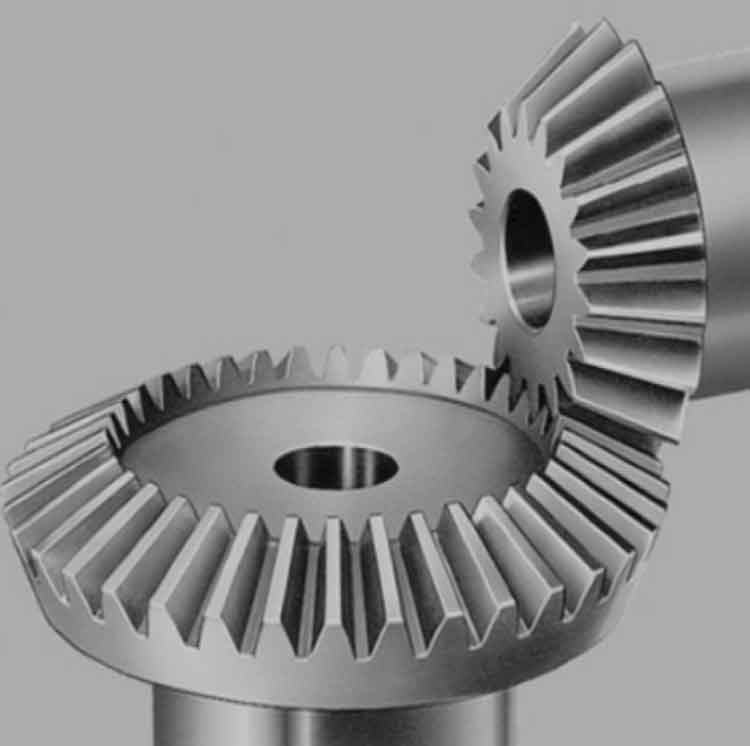Producing straight bevel gear in a cost-effective manner is a key objective for many manufacturing industries, including automotive, aerospace, and industrial machinery. Balancing quality with cost efficiency involves optimizing various aspects of the production process, from material selection to manufacturing techniques. This article explores the strategies and methodologies for achieving cost-effective production of straight bevel gear.

Introduction
Straight bevel gear is essential components that facilitate power transmission between intersecting shafts. Due to their critical role, it is imperative to produce these gears with high precision and durability while minimizing production costs. This requires a comprehensive understanding of material properties, manufacturing processes, and quality control measures.
Material Selection for Cost Efficiency
The choice of material significantly impacts both the performance and cost of straight bevel gear. Cost-effective production can be achieved by selecting materials that offer an optimal balance of cost, machinability, and mechanical properties.
- Alloy Steels: Commonly used for their strength and wear resistance. Examples include 8620, 4140, and 4340 steels.
- Carbon Steels: More cost-effective than alloy steels but with lower performance in high-stress applications. Examples include 1045 and 1050 steels.
- Powder Metallurgy (P/M) Materials: Offer cost savings through near-net shape production and reduced material waste.
Table 1: Common Materials for Straight Bevel Gear
| Material Type | Examples | Advantages | Disadvantages |
|---|---|---|---|
| Alloy Steels | 8620, 4140, 4340 | High strength and wear resistance | Higher cost |
| Carbon Steels | 1045, 1050 | Cost-effective, good machinability | Lower performance in stress |
| Powder Metallurgy | P/M materials | Reduced material waste, near-net shape | Limited mechanical properties |
Manufacturing Techniques
Optimizing manufacturing techniques is crucial for cost-effective production. Key techniques include:
- Precision Forging: Reduces material waste and machining time, resulting in cost savings.
- Gear Hobbing: A versatile and efficient method for producing high-quality gear.
- Heat Treatment: Enhances the mechanical properties of straight bevel gear, enabling the use of lower-cost materials without compromising performance.
Table 2: Manufacturing Techniques for Straight Bevel Gear
| Technique | Description | Benefits |
|---|---|---|
| Precision Forging | Produces near-net shape gears with minimal waste | Cost savings, reduced machining |
| Gear Hobbing | Involves cutting gear teeth using a hob | High precision, versatility |
| Heat Treatment | Processes like carburizing and quenching | Improved strength and wear resistance |
Process Optimization
Process optimization involves refining production workflows to enhance efficiency and reduce costs. This can be achieved through:
- Lean Manufacturing: Implementing lean principles to minimize waste and improve workflow efficiency.
- Automation: Utilizing automated machinery and robotics to increase production speed and consistency.
- Quality Control: Employing advanced inspection techniques to ensure product quality and reduce rework.
List of Process Optimization Strategies
- Implementing lean manufacturing principles
- Utilizing automation and robotics
- Employing advanced quality control techniques
- Streamlining production workflows
Cost Analysis and Optimization
Cost analysis is vital for identifying areas where savings can be achieved without compromising quality. This involves evaluating:
- Material Costs: Comparing the cost-effectiveness of different materials.
- Labor Costs: Analyzing labor efficiency and exploring opportunities for automation.
- Overhead Costs: Assessing indirect costs and identifying potential savings in energy consumption, equipment maintenance, and facility management.
Table 3: Cost Analysis Factors
| Cost Factor | Description | Optimization Strategy |
|---|---|---|
| Material Costs | Cost of raw materials used in production | Select cost-effective materials |
| Labor Costs | Wages and benefits for production workers | Increase labor efficiency, automation |
| Overhead Costs | Indirect costs such as energy and maintenance | Reduce energy consumption, preventive maintenance |
Enhancing Durability While Reducing Costs
Enhancing the durability of straight bevel gear while maintaining cost efficiency involves strategic use of materials, processes, and technologies. Key strategies include:
- Advanced Coatings: Applying coatings such as diamond-like carbon (DLC) to reduce wear and extend straight bevel gear life.
- Surface Hardening: Techniques like carburizing and nitriding can improve surface hardness and fatigue resistance.
- Design Optimization: Utilizing computer-aided design (CAD) and finite element analysis (FEA) to optimize straight bevel gear geometry for better performance and lower material usage.
List of Strategies for Enhancing Durability
- Applying advanced coatings (e.g., DLC)
- Utilizing surface hardening techniques (e.g., carburizing, nitriding)
- Optimizing gear design using CAD and FEA
Conclusion
Achieving cost-effective production of straight bevel gear requires a holistic approach that encompasses material selection, manufacturing techniques, process optimization, and cost analysis. By strategically balancing these elements, manufacturers can produce high-quality straight bevel gear that meet performance requirements while minimizing costs. Continuous advancements in materials science, manufacturing technology, and process optimization will further drive cost efficiencies in the production of straight bevel gear.
References
- Shigley, J. E., & Mischke, C. R. (2001). Mechanical Engineering Design. McGraw-Hill.
- Budynas, R. G., & Nisbett, J. K. (2015). Shigley’s Mechanical Engineering Design. McGraw-Hill Education.
- Norton, R. L. (2013). Machine Design: An Integrated Approach. Pearson.
This comprehensive analysis outlines the key aspects of cost-effective production of straight bevel gear, providing valuable insights for manufacturers aiming to optimize their production processes while maintaining high standards of quality and performance.
